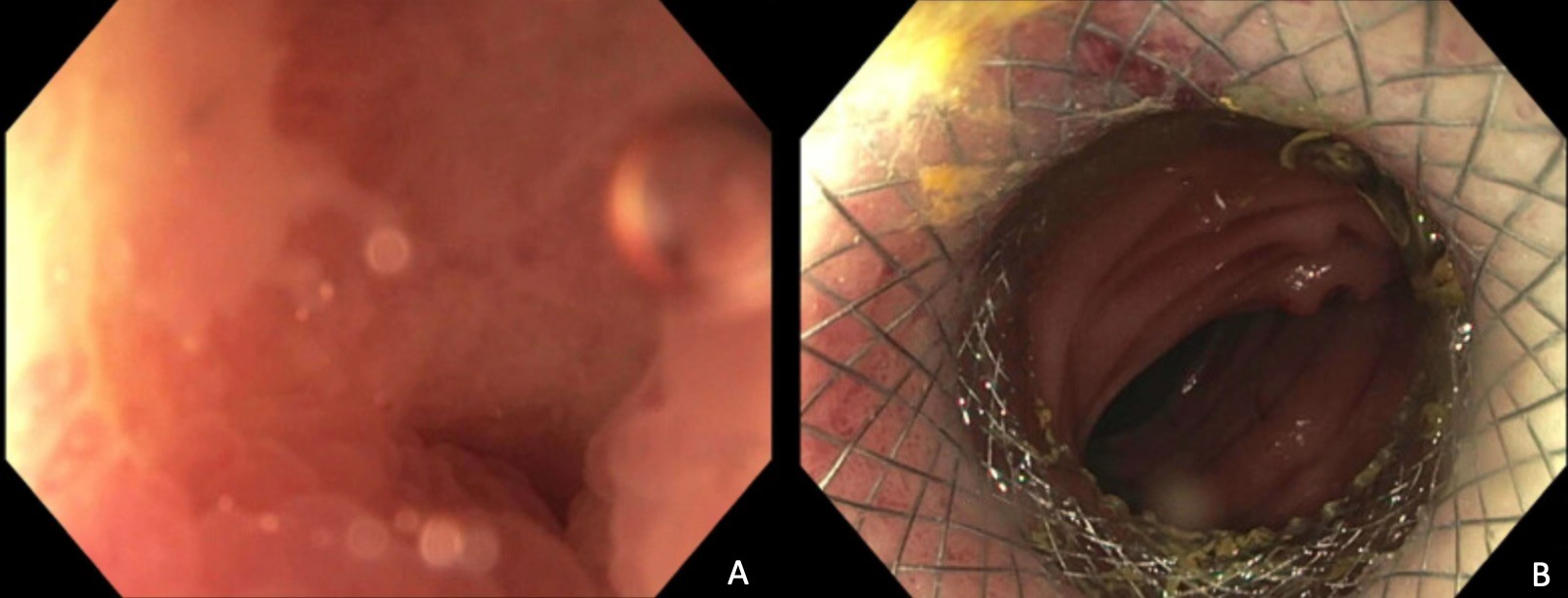Back
Poster Session D - Tuesday Morning
D0460 - A Bridge Over Troubled Anastomosis: Lumen Opposing Metal Stent for Dilation of Post-Whipple Stricture
Tuesday, October 25, 2022
10:00 AM – 12:00 PM ET
Location: Crown Ballroom

Byung Soo Yoo, MD
Carolinas Medical Center
Charlotte, NC
Presenting Author(s)
Byung Soo Yoo, MD1, Steve D'Souza, MD2, Alejandra Vargas, MD2, Parth Parekh, MD2
1Carolinas Medical Center, Charlotte, NC; 2Eastern Virginia Medical School, Norfolk, VA
Introduction: The Whipple procedure or pancreaticoduodenectomy is a resection surgery for pancreatic head cancer but has many complications. We present a case of obstruction of the gastrojejunal anastomosis in patient post-Whipple.
Case Description/Methods: A 71 year old male with a past medical history of pancreatic adenocarcinoma, one year status-post Whipple procedure presented with nausea, non-bloody emesis, and poor oral intake. A computed tomography of abdomen and pelvis demonstrated dilation of stomach and hepatic jejunostomy limb with soft tissue thickening at the level of the gastrojejunostomy staple line suggesting partial obstruction. Nasogastric tube was placed with significant output with intermittent blood. Upper endoscopy revealed a bleeding esophageal ulcer and was successfully clipped. The gastrojejunostomy was found to be healthy-appearing but the scope was not able to be advanced due to obstruction. Upper GI series demonstrated delayed passage of contrast, and the patient underwent repeat endoscopy 4 days later with dilation for severe stenosis at the efferent limb of gastrojejunal anastomosis. He continued to have symptoms and repeat imaging demonstrated persistence of gastric dilation, and he underwent deployment of lumen-opposing metal stent (LAMS) across the gastrojejunostomy stricture with overstitch. (Figure 1) The patient was able to slowly advance his diet and was discharged with plan for stent removal in 6 months.
Discussion: The Whipple procedure has known complications of delayed gastric emptying, pancreatic fistula, hemorrhage, and biliary leakage. The obstruction of the afferent or efferent limb of the gastrojejunal anastomosis is a rare complication of Whipple procedure that is often due to recurrent malignancy. Traditionally, the obstruction has been managed surgically or with balloon dilation, but LAMS has shown its utility in clinical outcomes and complication rates. Due to the complex anatomy of Whipple procedure and complications, it is important to consider stenosis of the gastrojejunal anastomosis in patients who present with gastrointestinal symptoms. In addition, LAMS can provide a less invasive and effective management option to such complication.

Disclosures:
Byung Soo Yoo, MD1, Steve D'Souza, MD2, Alejandra Vargas, MD2, Parth Parekh, MD2. D0460 - A Bridge Over Troubled Anastomosis: Lumen Opposing Metal Stent for Dilation of Post-Whipple Stricture, ACG 2022 Annual Scientific Meeting Abstracts. Charlotte, NC: American College of Gastroenterology.
1Carolinas Medical Center, Charlotte, NC; 2Eastern Virginia Medical School, Norfolk, VA
Introduction: The Whipple procedure or pancreaticoduodenectomy is a resection surgery for pancreatic head cancer but has many complications. We present a case of obstruction of the gastrojejunal anastomosis in patient post-Whipple.
Case Description/Methods: A 71 year old male with a past medical history of pancreatic adenocarcinoma, one year status-post Whipple procedure presented with nausea, non-bloody emesis, and poor oral intake. A computed tomography of abdomen and pelvis demonstrated dilation of stomach and hepatic jejunostomy limb with soft tissue thickening at the level of the gastrojejunostomy staple line suggesting partial obstruction. Nasogastric tube was placed with significant output with intermittent blood. Upper endoscopy revealed a bleeding esophageal ulcer and was successfully clipped. The gastrojejunostomy was found to be healthy-appearing but the scope was not able to be advanced due to obstruction. Upper GI series demonstrated delayed passage of contrast, and the patient underwent repeat endoscopy 4 days later with dilation for severe stenosis at the efferent limb of gastrojejunal anastomosis. He continued to have symptoms and repeat imaging demonstrated persistence of gastric dilation, and he underwent deployment of lumen-opposing metal stent (LAMS) across the gastrojejunostomy stricture with overstitch. (Figure 1) The patient was able to slowly advance his diet and was discharged with plan for stent removal in 6 months.
Discussion: The Whipple procedure has known complications of delayed gastric emptying, pancreatic fistula, hemorrhage, and biliary leakage. The obstruction of the afferent or efferent limb of the gastrojejunal anastomosis is a rare complication of Whipple procedure that is often due to recurrent malignancy. Traditionally, the obstruction has been managed surgically or with balloon dilation, but LAMS has shown its utility in clinical outcomes and complication rates. Due to the complex anatomy of Whipple procedure and complications, it is important to consider stenosis of the gastrojejunal anastomosis in patients who present with gastrointestinal symptoms. In addition, LAMS can provide a less invasive and effective management option to such complication.

Figure: Figure 1. A - Stricture at the efferent limb of the gastrojejunal anastomosis. B - The efferent limb following LAMS deployment
Disclosures:
Byung Soo Yoo indicated no relevant financial relationships.
Steve D'Souza indicated no relevant financial relationships.
Alejandra Vargas indicated no relevant financial relationships.
Parth Parekh indicated no relevant financial relationships.
Byung Soo Yoo, MD1, Steve D'Souza, MD2, Alejandra Vargas, MD2, Parth Parekh, MD2. D0460 - A Bridge Over Troubled Anastomosis: Lumen Opposing Metal Stent for Dilation of Post-Whipple Stricture, ACG 2022 Annual Scientific Meeting Abstracts. Charlotte, NC: American College of Gastroenterology.
